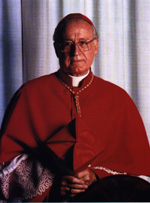| An afternoon in the place where European
culture started to remake itself (Sunday, 6 July 2003) |
 |
Saint Benedict was born of noble parents in the region of Nursia, towards the year 480. We know he had a sister, called Scholastica, who had consecrated herself to God while still young. Having completed his first studies in his native land, Benedict went to Rome for advanced studies. He did not remain there very long, negatively impressed as he was by Roman corruption. After a brief stay in Affile, he longed for greater solitude. Perhaps the young man had heard about the Monastery of Adeodato. On the way up Mount Taleo, on the right shore of the Anio river, he found the monk Romanus, who showed him a horrible cave, situated precisely under his monastery. Saint Benedict stayed in the cave for three years, ignored by all, except God and the monk Romanus, who from the top of the rocky wall where the cave was, sent down a portion of his own food on a long rope in order to feed the young eremite. In spite of the generous and discrete assistance of Romanus, the life of Saint Benedict in the cave was very hard. There were certainly moments of discouragement and of temptation.
After three years, his solitude started to decrease. He was later called to lead a nearby monastery, but the monks, considering him to be too severe, forced him leave. This allowed the saint to return to his solitude. His name was already known, and many disciples came from all over to join him. The saint established himself with his disciples on the shore of the highest of Neronian Lakes, probably using a building from the imperial villa which was still in good condition. Saint Benedict lived in this place for more than twenty years, and here began, and was perfected that type of monastic life reflected in the Benedictine Rule, the first writing of which corresponds precisely to those years in the Subiaco cenobium, next to the Neronian Lake. Many disciples came to him – of different ages, origins and social conditions.
From that cave, profoundly transformed – as an ancient inscription on the rock recalls – Benedict sent his monks to evangelise France, England, Germania, Hispania – ‘where he converted the Visigoths’ – and many other countries.
Nothing was easy then. As nothing is easy in our time, but the way that was done, is recalled right there by another sentence of Saint Benedict: ‘Through obedience we participate in the work for God; through patience we participate in the passions of Christ’.
On leaving the place, I thought to myself that – fifteen centuries later – the work (evangelisation) for God, and patience in difficulties and suffering, which unite us to the passion of Christ, continue to be necessary.
+Ricard-Maria Cardinal Carles, Emeritus Archbishop of Barcelona